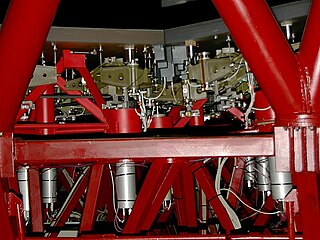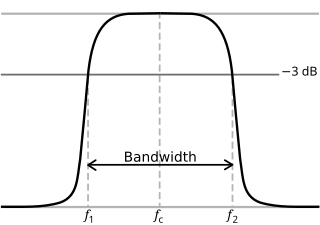In adaptive optics, the Greenwood frequency [1] is the frequency or bandwidth required for optimal correction with an adaptive optics system. It depends on the transverse windspeed and the turbulence strength in the atmosphere. This can be easily understood since if the turbulence moves over the telescope opening faster, the speed at which the wavefront needs to be corrected is higher, and vice versa. There are various ways to define the Greenwood frequency, but all the definitions attempt to represent the frequency at which the turbulence distortion of the image is changing. The reciprocal of the Greenwood frequency is sometimes known as the Greenwood or atmospheric time constant (τ0). Since the distortions are approximately constant over a period less than this time constant, adapting the optical system at a faster rate yields negligible benefits; conversely, adaptive system performance degrades significantly as the response speed decreases below the Greenwood value, since that means that the distortions are changing faster than the system can adapt. Greenwood frequencies in common applications typically run from tens of hertz up to hundreds or even a few kilohertz, but unusual atmospheric conditions or unusual optical equipment can give very different values.

Adaptive optics (AO) is a technology used to improve the performance of optical systems by reducing the effect of incoming wavefront distortions by deforming a mirror in order to compensate for the distortion. It is used in astronomical telescopes and laser communication systems to remove the effects of atmospheric distortion, in microscopy, optical fabrication and in retinal imaging systems to reduce optical aberrations. Adaptive optics works by measuring the distortions in a wavefront and compensating for them with a device that corrects those errors such as a deformable mirror or a liquid crystal array.

Bandwidth is the difference between the upper and lower frequencies in a continuous band of frequencies. It is typically measured in hertz, and depending on context, may specifically refer to passband bandwidth or baseband bandwidth. Passband bandwidth is the difference between the upper and lower cutoff frequencies of, for example, a band-pass filter, a communication channel, or a signal spectrum. Baseband bandwidth applies to a low-pass filter or baseband signal; the bandwidth is equal to its upper cutoff frequency.

In physics, a wavefront is the locus of points characterized by propagation of positions of identical phase: propagation of a point in 1D, a curve in 2D or a surface in 3D. For an electromagnetic wave, the wavefront is represented as a surface of identical phase, and can be modified with conventional optics. For instance, a lens can change the shape of optical wavefronts from planar to spherical as the lens introduces a spatial phase variation across the beam shape.
One expression for the Greenwood frequency is given by
With the zenith angle, the windspeed as function of height and the so-called atmospheric turbulence constant structure function, a measure of the turbulence strength as function of height.

The zenith is an imaginary point directly "above" a particular location, on the imaginary celestial sphere. "Above" means in the vertical direction opposite to the apparent gravitational force at that location. The opposite direction, i.e. the direction in which gravity pulls, is toward the nadir. The zenith is the "highest" point on the celestial sphere.











